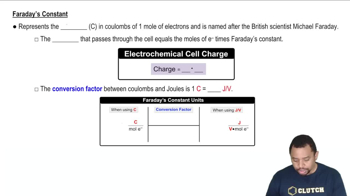Textbook Question
(d) Why is sodium metal not obtained when an aqueous solution of NaCl undergoes electrolysis?

 Verified step by step guidance
Verified step by step guidance



(d) Why is sodium metal not obtained when an aqueous solution of NaCl undergoes electrolysis?
(d) Why are active metals such as Al obtained by electrolysis using molten salts rather than aqueous solutions?
(a) A Cr3+(aq) solution is electrolyzed, using a current of 7.60 A. What mass of Cr(s) is plated out after 2.00 days?
(a) Calculate the mass of Li formed by electrolysis of molten LiCl by a current of 7.5 × 104 A flowing for a period of 24 h. Assume the electrolytic cell is 85% efficient. (b) What is the minimum voltage required to drive the reaction?